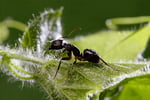To my surprise the other day, while I was sitting at my desk, our Vice President of Operations came up to me and said he found an armyworm outside our office. When he first mentioned armyworm to me I immediately had a vision of a small worm dressed in fatigues, brandishing a riffle ready for battle. To my surprise instead he handed me a small container with a green and brown colored worm moving around inside it. Soon I was to learn that small caterpillar looking bug, which actually turns into a moth, can be a huge danger to lawns as well as field crops such as corn and wheat.
 |
Picture of the army worm found outside our office
Armyworms, given their name because of their tendency to feed in large groups, can be one of the most destructive bugs to attack your lawn. They can make quick work of patches of your lawn almost overnight which makes them even harder to deal with. By the time you notice their damage they have can have already moved on to another patch of ground.
Breakouts of armyworms can be hard to plan for because they do not happen normally, but when they do become noticeable the damage can be felt far after they leave. They can be difficult to discover as well because they hide during the day, while feeding and moving at night or early morning. Just like an invading army, they seem organized and use numbers to take sections of ground at a time.
 |
| Armyworm's can cause damage to leaves and lawns quickly due to their concentrated effort. |
The best course of action is call in the big guns, and contact a professional lawn care expert who has the tools necessarily to deal with this invading force. Armyworms are nothing to take lightly and the health of your lawn could be at stake.










